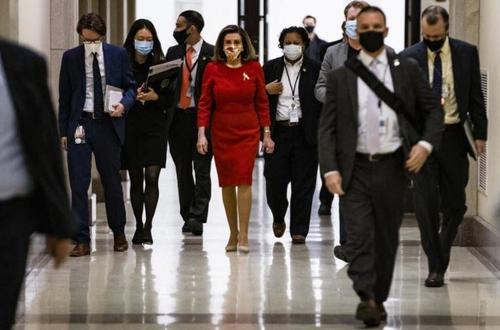By Adam Andrzejewski, CEO/Founder of OpenTheBooks.com, first published in Forbes
Over the weekend, the U.S. House posted a first draft version of the “American Rescue Plan Act of 2021” – a $1.9 trillion emergency aid package to help America recover from the coronavirus pandemic.

Since House Speaker Nancy Pelosi’s leadership team essentially wrote the bill, our auditors at OpenTheBooks.com found what House Democrats consider coronavirus-recovery “essential” spending:
- $1.5 million earmarked for the Seaway International Bridge, which connects New York to Canada. Senate Leader Chuck Schumer hails from New York.
- $50 million for “family planning” – going to non-profits, i.e. Planned Parenthood, or public entities, including for “services for adolescents[.]”
- $852 million for AmeriCorps, AmeriCorps Vista, and the National Senior Service Corps – the Corporation for National and Community Service – civic volunteer agencies. This includes $9 million for the AmeriCorp inspector general to conduct oversight and audits of the largess. AmeriCorps received a $1.1 billion FY2020 appropriation.
People of goodwill can debate each of these goals, but is it truly emergency spending or funding related to COVID?
For example, what is the public purpose for a hike in the minimum wage to $15 per hour – which the non-partisan Congressional Budget Office (CBO) says will cost the economy 1.4 million jobs?
Certainly, the coronavirus stimulus bill does provide $473 billion in payments to individuals, $75 billion in cash for vaccines, $26 billion to restaurants, $15 billion to help fund airline payrolls, and another $7.2 billion in Paycheck Protection Program funding for small businesses.
However, The Wall Street Journal editorial board estimated that only $825 billion was directly related to COVID-relief and $1 trillion was “expansions of progressive programs, pork, and unrelated policy changes.”
For example, separately, our auditors found that $470 million in the bill doubles the budgets of The Institute of Museum and Library Services and the National Endowment of the Arts and the Humanities.
- $200 million in the bill to The Institute of Museum and Library Services (FY2019 budget: $230 million). This agency is so small that it doesn’t even employ an inspector general.
- $270 million funds the National Endowment of the Arts and the Humanities (FY2019 budget: $253 million) – In 2017, our study showed eighty-percent of all non-profit grant making flowed to well-heeled organizations with over $1 million in assets.
A quick spotlight on agencies and entities receiving “coronavirus recovery” money in the bill includes:
- $350 billion to bailout the 50 States and the District of Columbia. The allocation formula uses the unemployment rate in the fourth quarter of 2020. Therefore, states like New York and California –who had strict economic lockdown policies and high unemployment – will get bailout money. States like Florida and South Dakota – who were open for business – will get less.
- $128.5 billion to fund K-12 education. The CBO determined that most of the money in education will be distributed in 2022 through 2028, when the pandemic is over.
- $86 billion to save nearly 200 pension plans insured by the Pension Benefit Guaranty Corp. There are no reforms mandated while these badly managed pensions are bailed-out. Many of these pension plans are co-managed by unions.
- $50 billion goes to the Federal Emergency Management Agency (FEMA). A portion of these funds is earmarked to reimburse up to $7,000 for funeral and burial costs related to COVID deaths.
- $39.6 billion to higher education. This amount is three times the money – $12.5 billion – that higher ed received with the massive CARES Act funding from last March.
- $1.5 billion for Amtrak – the National Railroad Passenger Corporation. In FY2020, Congress appropriated $3 billion for Amtrak ($2 billion in annual appropriations, plus an additional $1 billion in the CARES Act COVID relief bill). In the three years before the pandemic, AMTRAK lost $392 million – even after a $5 billion taxpayer subsidy (FY2017-FY2019).
We reached out to Speaker Pelosi for comment and will update the piece if there is a response.
During the past three years, Republicans and Democrats have helped drain the U.S. Treasury from the left and the right. Our national debt increased from $10 trillion (2008) to $19.6 trillion (2016) to $23.6 trillion (2020) and stands at $28 trillion today.
Continuing coronavirus responses and bloated legislation will drive the national debt much higher.









